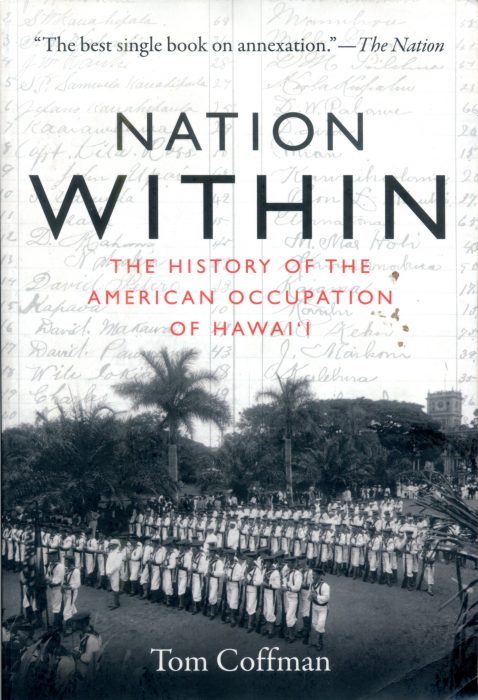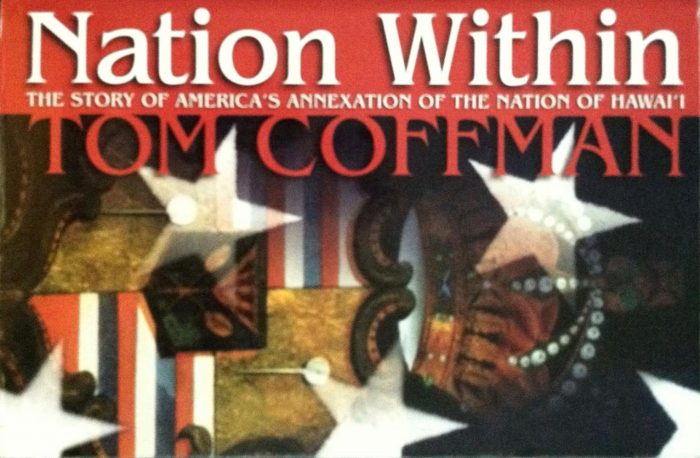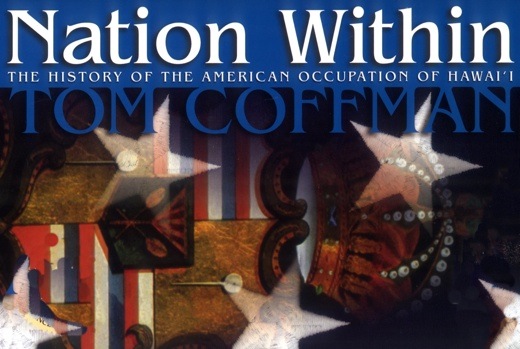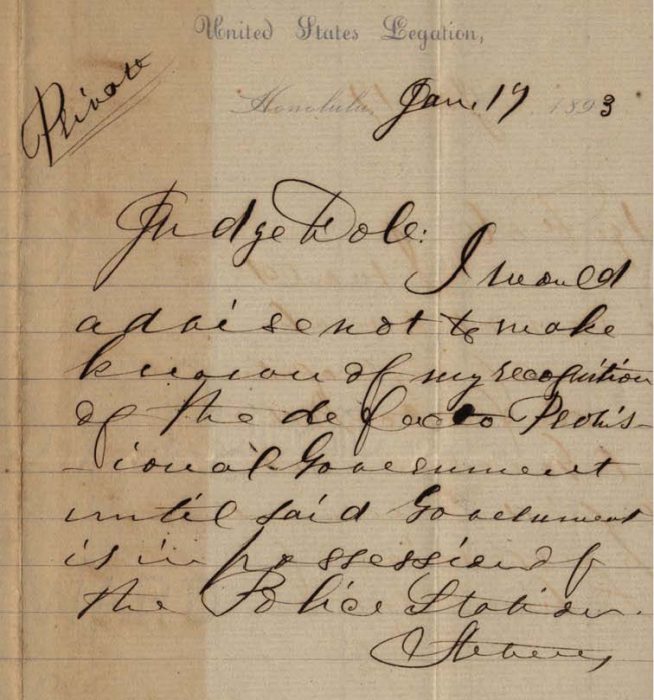In 2016, Duke University Press published Tom Coffman’s Nation Within: The History of the American Occupation of Hawai‘i. While this book has been in circulation since 1998, it is the first time that an academic publisher has put its name to the book. The goal of Duke University Press is “to contribute boldly to the international community of scholarship.” “By insisting on thorough peer review procedures in combination with careful editorial judgment, the Press performs an intellectual gatekeeping function, ensuring that only scholarship of the highest quality receives the imprimatur of the University.”

Dr. Keanu Sai, a political scientist, whose doctoral research covered the American occupation of the Hawaiian Kingdom and its continued existence today as an independent State, was asked by the Hawaiian Journal of History to write a book review of Coffman’s Nation Within for its first publication in 2017. In his review, Dr. Sai reveals the “smoking gun” that was brought to his attention by Dr. Ron Williams of the University of Hawai‘i at Manoa.
***************************************************************
In Nation Within: The History of the American Occupation of Hawai‘i, Tom Coffman exhibits a radical shift by historians in interpreting political events post-1893. When Coffman first published his book in 1998, his title reflected a common misunderstanding of annexation. But in 2009, he revised the title by replacing the word Annexation with the word Occupation. Coffman admitted he made this change because of international law (p. xvi). By shifting the interpretive lens to international law, Coffman not only changed the view to occupation, but would also change the view of the government’s overthrow in 1893. While the book lacks any explanation of applicable international laws, he does an excellent job of providing an easy reading of facts for international law to interpret.


In international law, there is a fundamental rule that diplomats have a duty to not intervene in the internal affairs of the sovereign State they are accredited to. Every sovereign State has a right “to establish, alter, or abolish, its own municipal constitution [and] no foreign State can interfere with the exercise of this right” (Halleck’s International Law, 3rd ed., p. 94). For an ambassador, a violation of this rule would have grave consequences. An offended State could proceed “against an ambassador as a public enemy…if justice should be refused by his own sovereign” (Wheaton’s International Law, 8th ed., p. 301).
John Stevens, the American ambassador to the Hawaiian Kingdom arrived in the islands in the summer of 1889. As Coffman notes, Stevens was already fixated with annexation when he “wrote that the ‘golden hour’ for resolving the future status of Hawai‘i was at hand,” (p. 114) and began to collude with Lorrin Thurston (p. 116). Thurston was not an American citizen but rather a third-generation Hawaiian subject. Stevens’ opportunity to intervene and seek annexation would occur after Lili‘uokalani “attempted to promulgate a new constitution, [which] was the event Thurston and Stevens had been waiting for” (p. 120).
On January 16, Stevens orders the landing of U.S. troops and “tells Thurston that if the annexationists control three buildings—‘Iolani Palace, Ali‘iolani Hale, and the Archives—he will announce American recognition of the new government” (p. 121). The following day, “Stevens tells the queen’s cabinet that he will protect the annexationists if they are attacked or arrested by government police” (Ibid.). However, unbeknownst to Stevens, the insurgents only took over Ali‘iolani Hale, which housed “clerks of the Kingdom” (p. 125). One of the insurgents, Samuel Damon, knowing Stevens’ recognition was premature, sought to convince Lili‘uokalani that her resistance was futile because the United States had already recognized the new government, and that she should order Marshal Charles Wilson, head of the government police, to give up the police station. Wilson was planning an assault on the government building to apprehend the insurgents for treason in spite of the presence of U.S. troops.
International law clearly interprets these events as intervention and Stevens to be a “public enemy” of the Hawaiian Kingdom. This was the same conclusion reached by President Grover Cleveland, whose investigation was an indictment of Stevens and the commander of the USS Boston, Captain Gilbert Wiltse. “The lawful Government of Hawai‘i was overthrown without the drawing of a sword or the firing of a shot,” Cleveland said, “by a process every step of which, it may be safely asserted, is directly traceable to and dependent for its success upon the agency of the United States acting through its diplomatic and naval representatives” (p. 144). Because of diplomatic immunity, the United States, as the sending State, would be obliged to prosecute Stevens and Wiltse for treason under American law.
On December 20, 1893, a resolution of the U.S. Senate called for a separate investigation to be conducted by the Senate Committee on Foreign Relations. Chaired by Senator John Morgan, a vocal annexationist, the purpose of the Senate investigation was to repudiate Cleveland’s investigation and to vindicate Stevens and Wiltse of criminal liability. One week later, the Committee held its first day of hearings in Washington, DC. Stevens appeared before the Committee and fielded questions under oath on January 20, 1894. When asked by the Chairman if his recognition of the provisional government was for the “purpose of dethroning the Queen,” he responded, “Not the slightest—absolute noninterference was my purpose” (Report from the Committee on Foreign Relations— Appendix, p. 550).
After the hearings, two reports were submitted on February 26, 1894—a Committee Report and a Minority Report. The committee of eight senators was split down the middle, with Morgan giving the majority vote for the Committee Report. Half of the committee members did not believe Stevens’ testimony of his non-intervention. The Minority Report stated, “We can not concur…in so much of the foregoing report as exonerates the minister of the United States, Mr. Stevens, from active officious and unbecoming participation in the events which led to the revolution” (Ibid., p. xxxv).
The Senate Committee’s investigation could find no direct evidence that would disprove Stevens’ sworn testimony, but in 2016, the “smoking gun” was found that would prove Stevens was a public enemy of the Hawaiian Kingdom, committed perjury before the Committee, and would no doubt have been prosecuted under the 1790 federal statute of treason. The Hawaiian Mission Houses Archives is processing a collection of documents given to them by a descendent of William O. Smith. Smith was an insurgent that served as the attorney general for Sanford Dole, so-called president of the provisional government.
The “smoking gun” is a note to Dole signed by Stevens marked “private” and written under the letterhead of the “United States Legation” in Honolulu and dated January 17, 1893. Stevens writes, “Judge Dole: I would advise not to make known of my recognition of the de facto Provisional Government until said Government is in possession of the police station.”
As a political scientist, Coffman’s book is a welcomed addition to arresting revisionist history.


Cool..I want to read it
This was orchestrated by the U.S. Secy of State, James G. Blaine and supported by U.S. President Benjamin Harrison and key figures in Washington, D.C. Thurston was enlisted in the plot. The Turpie Resolution of 1894 threatened any U.S. government officials and other nations from intervening lest it be an unfriendly act against the United States. The Committee of Safety was a pawn and scapegoat to hide the actions of the U.S. wh set up the puppet government of the Provisional government.
Great information in this post. Can’t believe this idiot Stevens would implicate himself of the crime in writing. This is better than wiki leaks by far. Thank you Mr. Stevens for being such a dumb crook.
What’s this treaty with Woodrow Wilson 1912War Invasion of Europe And Hawaiian Kingdom tell us the One hundred Years of Borrowing Prince Kuhio’s entitlement since then .Isaac Kamaile Jr.
I saw a video about this letter on Vimeo a while ago. They also had an original letter from Queen Liliuokalani to Sanford Dole in the collection.
The true historical narrative of our Hawaiian Kingdom continues to unwind. The depth of the deception of the U.S. shows in our brainwashed minds through the Americanization of our nationality…GENOCIDE thru INSIDIOUS EDUCATION. We the people are the evidence of the crime. De-occupation will happen. For those of us who FEAR this happening should remember fear’s acronym: F-false. E-evidence. A-appearing. R-real. Look to our past and the brilliance of our Kupuna. What they knew we are only BEGINNING to learn…
Maika`i Madonna even to the acronym. Additionally the americanization of my parents left me as a problem child in my family even while kupuna were whispering “not legal” in my early years. I pule for the courage to change this. Mahalo sister.
When we were researching for our documentary, ACT OF WAR – THE OVERTHROW OF THE HAWAIIAN NATION, we were told about a secret coded message telegraphed from the U.S. government to the U.S.S. Boston, G. Wiltse commanding, instructing the Boston to aide in the overthrow of the Hawaiian Kingdom government. We were never able to find that document, which had been dubbed “the smoking gun”. Also, historians say it was known that Secretary Blaine did not put many things in writing. So nice to find Stevens’ message now seeing the light of day. I wonder what more will come out in the future. As a researcher once told me, “We are sitting on a mountain of secrets.”
Go to loc.gov and you will find a lot more incriminating evidence of U.S. orchestration of the plot in journals such as the North American Review, The WASP, and other communications among the plotters.
Aloha Joan,
I’m not sure if this is the document you are talking about, I retyped it as I was having a hard time trying to copy and paste it for your viewing.
I type it word for word as it was written, but the upper portion is a little mixed between both the coded words and the deciphered words. The lower portion is easier to understand as the coded words are capitalized and the deciphered messages are after the = signs.
The secret coded message of August 13, 1892 begins the operation to overthrow Hawaii
Code Word Code Code Meaning
Amphilogy amphilogy “Have received following answer” (from)
Adalant & Astrict adhalanti “If you can act please do so”
Adecimarf & Lawinding edecan “Instructions received & carried out”
Galaglas Sexuality galasia “Is in a position to”
On October 20, 1897 W.A. Cooper Despatch Agent San Francisco sends a cipher message to Seawall by first steamer to Honolulu. Of the four code books reviewed, some compromised, reveals the following. Parts of deciphered coded message of August 13, 1892 (performed by former military code technician, Henry Lindsey) using Navy Secret Code Book 1887.
ACHATABE = according to the president’s (Commander-in-Chief’s) instructions
FLANDERLET = execute (his) orders as quickly as possible.
GEMMEUR = proceed at once to (Hawaii)
APFEL = as soon as you arrive (there)
HORTULAN = (you) are advised to sail along the island (chain)
DASILE-DISANCOLA = fire heavy cannon to threaten (&)
CARPING = create (fear) at each
EMBLAZONARY = island
CHUNOS = (your final) destination (is)
DICIANO = (the) Harbor at (Honolulu)
ENTRONIUS = (a) decision has been rendered
LUMAVERAT = to support
DETECTOREM = (a) Provisional Government
ARCHANDER = assist
CARNIVAL = United State’s foreign Affairs (Stevens)
EVACUARON = (he will ask for armed) military
MORBIDABAT = troops
PASHAWS = (with) weapons (to be landed)
GIFTBLASE = to protect interest of
ETHERIZING = members of the
DETECTOREM = Provisional Government
ARTSMAN = you are authorized to take all necessary steps to protect our interest
HABUIMUS = remain there for the present (&)
FLENSHING = wait for further orders
This secret telegram and orders was the dry run for the actual events that were followed to the letter. To dismay long time residents and refute the 1893 NHSC findings of denial.
If you wouldn’t mind, can you source this? in the sense of identifying where a researcher could locate it? If you have done this already, I missed it. if you wish to respond privately my email is stevelaudig@gmail.com. In return I will share a passage from Lucien Young’s “The Boston in Hawaii” [1898] at page 186 which references something similar. Wiltse “read a short letter of instructions to them. These instructions were taken bodily from his confidential letter from the Navy Department, and were prepared in the morning when he first decided to land.” cheers.
Aloha Steve,
I have no problem giving this information to everyone. I first heard of this document while watching the program “Aloha Aina Talk Story”, hosted by Ann Keala Kelly.
The program was aired two years ago and Uncle Louis Buzzy Agard was the guest. Uncle Buzzy had published a book in 1982, titled ” politics HAWAII SANDALWOOD TREES and hope” and the document I posted earlier was from page #128 of this book.
It is a very interesting book and I purchased my copy from Na Mea Hawaii at Ward Center. There are two copies available, there is a short summarized version and there is the long version.
A Hui Hou
I’m sorry Steve, I forgot to mention that a copy of the actual coded telegram dated August 13, 1892 is on page #88 of the Uncle Buzzy’s long version publication.
I believe the encrypted message to the boston was to shell the coast line of the islands causing the kanaka maoli to flee inland and disrupt their relation with the queen. I cannot for now remember the name of the maoli kane who did the intensive research but evidence exist from the u.s. national archives.
The new cover on the book is quite fitting! Now it looks like Hawaii is occupied! One of the things that are hiding that reality unfortunately is de-nationalization and the puppet regime!
I watched an interview with Buzzy Agard a year or more ago. He and Henry Lindsey, a WWII military code breaker, worked together and were able to de- code the naval dispatch which gave orders to shell coastal communities on all islands. this in itself is another revealed
lie by the U S in denying their participation in the overthrow. By the way, I’m no relation to the Stevens mentioned above
My my ku’kai a famous poets words “Oh the tangled Web we weave when we set out to deceive ” mahalo my kapuna may akua bless you